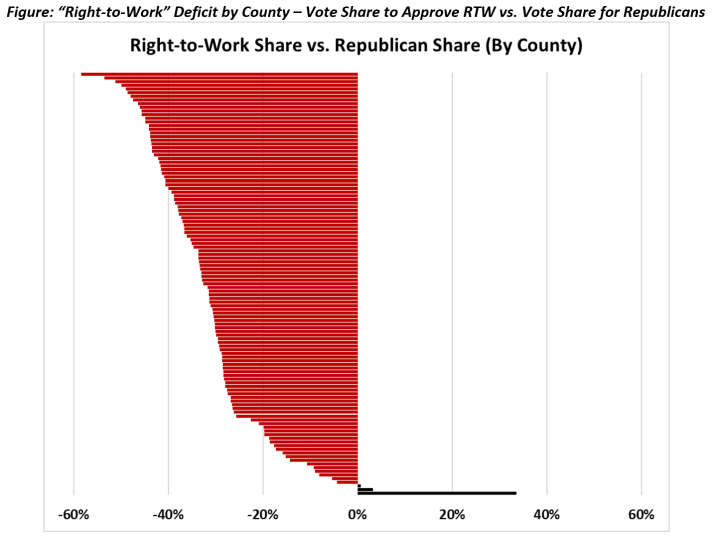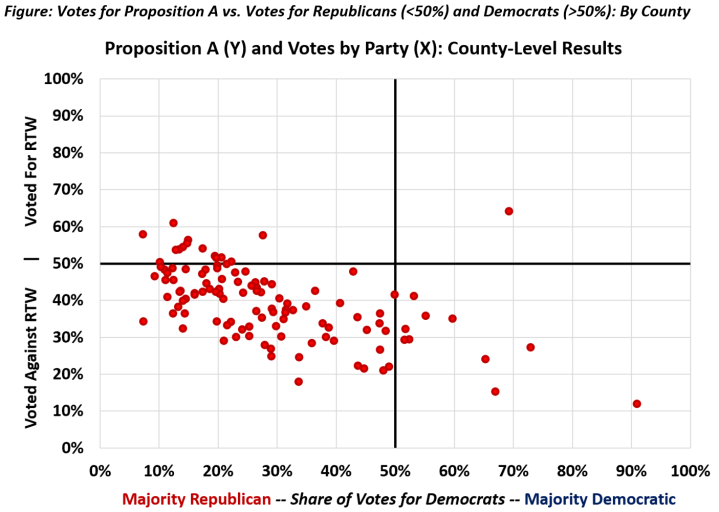Key Findings:
- More Missouri voters cast ballots in the Proposition A referendum to approve or reject “right-to-work” than voted for a candidate for U.S. Senate.
- The pro-union gap was 20 percentage points.
- 86% of Republican-majority counties in Missouri voted against “right-to-work.”
A so-called “right-to-work” law allows workers to not pay membership dues but still receive all the services, benefits, and representation that unions provide – for free. Last week, voters in Missouri overwhelmingly rejected this policy, which aims to weaken unions. In other Midwest states that have recently passed “right-to-work” laws, union membership has declined and middle-class worker wages have fallen by 3%.
There was significant voter interest in Proposition A to either approve or reject “right-to-work” in Missouri’s August 2018 primary elections. In fact, 1.39 million Missouri voters cast votes for Proposition A compared to just 1.28 million who cast votes for a candidate for U.S. Senate, meaning the referendum received 9% more votes than all Republican, Democratic, and third-party candidates.
All state and county-level data is from https://www.sos.mo.gov/elections/s_default and is available at goo.gl/NGg34Y.
The Labor Movement Received Bipartisan Support
The pro-union gap measures the increase in votes against “right-to-work” over what would be expected if the vote was simply split along partisan lines.
The pro-union gap is the difference between the share of ballots cast for Democratic candidates (47.5%) and the share of ballots cast to reject the “right-to-work” law in Missouri’s August 2018 primary elections (67.5%). Because more Missourians voted for Republican candidates than Democratic candidates, the labor movement needed substantial numbers of rank-and-file Republicans in the state to vote against “right-to-work” in order to defeat the policy. They did.
The pro-union gap was 20 percentage points– a bipartisan rejection of “right-to-work” in Missouri.

The pro-union vote share vs. Democratic vote share was 30 percentage points or higher in 72 of the 115 counties in Missouri (63%).
It was over 40 points in many counties, including places like Henry County– a rural county that went 71% for Donald Trump in the 2016 presidential election. In Henry County, 79% of 2018 primary voters cast ballots for Republican candidates versus 21% who voted for Democratic candidates. However, “right-to-work” was rejected in this county by 71% of voters – translating into a pro-union gap of 50 points and indicating that a super-majority of local Republicans voted in favor of the labor movement.

On the other hand, the figure below shows the “right-to-work” deficit for each Missouri county– or the share of votes to approve “right-to-work” compared to the share of votes for Republican candidates. Results are sorted from the largest gap to the smallest. “Right-to-work” only had more support than the overall Republican share in 3 Missouri counties. “Right-to-work” did significantly worse in the remaining 112 counties.

86% of Republican-Majority Counties in Missouri Rejected “Right-to-Work”
Lastly, “right-to-work” was rejected in 89 of the 103 Missouri counties (86%) that cast a majority of ballots for Republican candidates. In the graph below, these majority-Republican, pro-union counties are the counties in the lower-left quadrant. Of the 12 majority-Democratic counties, which are generally more populous than the rest of the state, 11 voted against “right-to-work” (92%). The labor movement thus received significant support from both sides of the political aisle in Missouri’s August 2018 primary elections.

Voters in Missouri rejected a policy that would have eroded the state’s middle class and caused additional inequality. The results from last week should make elected officials in Illinois and across the Midwest think twice about passing legislation that weakens the bargaining power of working-class families.
Related posts:
